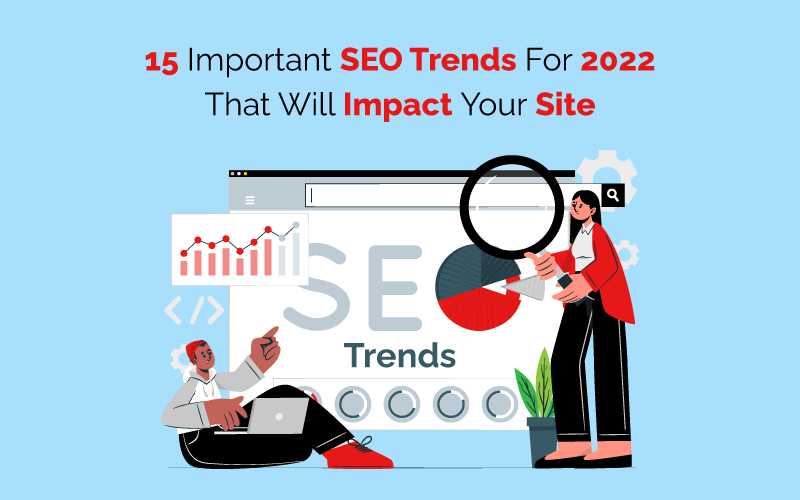
Table of Contents
- Introduction
- For rankings and visibility
- All the SEO Trends in 2023 to look out for
- 1. User Experience assumes new meaning with Core Web Vitals
- 2. New Structured Data Markups for Video SEO
- 3. Artificial Intelligence: MUM set to take over BERT
- 4. Focus on User Behavior and Search Intent
- 5. Voice Search through Machine Learning Models: LaMDA
- 6. Improvement in Predictive Search
- 7. From Pages to Passages: Passage Indexing and Ranking
- 8. Focus on Online Shopping: Shopping Graph
- 9. Increasing the Value of Featured Snippets
- 10. EAT is here to stay: Updates and Refinements
- 11. SERP rankings will depend on Long-Form Content
- 12. Keyword Search: Increased Emphasis on Semantically Related Keywords
- 13. Automation is more important than ever
- 14. Spotlight on Local Search
- 15. Internal Linking never went out of business
- Conclusion
Introduction
It’s no secret that Search Engine Optimization is an essential part of digital marketing. Effective SEO implementationensures a constant flow of traffic to your online platform. Today, when a solid digital presence has become abenchmark for success, becoming relevant to the search queries of users can take your online venture places. The key to attracting these users to your online platform lies in devising and implementing an SEO strategy that takes it to the top of SERP(Search Engine ResultsPage). SEO has cemented its position as perhaps the most valuable and consistent marketing tool for digital marketers, and rightly so. Given the influence it has over the process of attracting users, it can not remain stagnant with the way it operates. The SEO industry is highly unpredictable and keeps evolving very rapidly. The frequency of changes in SEO industry trends is such that if you would stop paying attention even for just a few weeks, you would return to an entirely different playing field. The volatility of SEO trends makes search engine optimizers one of the most resilient working professionals in the industry — because of the frequently evolving nature of their area of expertise. Missing out on the top SEO trend changes can render the long-term efforts of SEO practitioners virtually useless, in a jiffy. Therefore, it’s of essential importance for SEO industry professionals to keep themselves updated with the latest changes and upgrades in SEO trends for making SEO strategies for clients that can put their business on top of SERP. Despite many speculations and false murmurs for a couple of years, regarding the fading nature of the importance of SEO, in reality, SEO has only thrived. No doubt it has changed beyond anyone’s expectations, but the changes have been aimed at making the user experience the focal point of content creation and optimization strategies. Attracting organic traffic to a website has increasingly become an exercise of designing it to ease navigation, content comprehension, and adding value to visiting users.
 Google has always been in constant pursuit of improving search results for its users — which can be seen through the lens of hundreds of search algorithm changes and tweaks year on year. These algorithmic changes are enough to keep SEO practitioners in a permanent state of learning and perfecting their skills to help clients achieve their organic traffic goals. Google’s commitment to user experience has helped in giving shape to the SEO of today with landmark changes in the last few years. It’s vital to understand, once again, why SEO holds such importance in determining the flow of organic traffic to a website and why organic traffic reigns supreme. Let’s take a look at the reasons why SEO and Organic Traffic are important.
Google has always been in constant pursuit of improving search results for its users — which can be seen through the lens of hundreds of search algorithm changes and tweaks year on year. These algorithmic changes are enough to keep SEO practitioners in a permanent state of learning and perfecting their skills to help clients achieve their organic traffic goals. Google’s commitment to user experience has helped in giving shape to the SEO of today with landmark changes in the last few years. It’s vital to understand, once again, why SEO holds such importance in determining the flow of organic traffic to a website and why organic traffic reigns supreme. Let’s take a look at the reasons why SEO and Organic Traffic are important.
For rankings and visibility
Rankings of a webpage on SERP determine the chances of users interacting and visiting a webpage. It has been observed in several surveys over the years that users tend to gravitate towards clicking on the first few links of the first search results page on Google (and other search engines) — meaning that the higher your SERP ranking, the more likely it is for a prospective visitor to click on the link to your website. The visibility of a website depends on following the best practices involved in making the user experience better and establishing a rapport with the search algorithms of Google. The key is to optimize your website for organic page rankings because users avoid clicking on the paid links as they lack showing trust in them. The solution hinges on SEO.

Organic Traffic
Drawing on visibility and rankings, as discussed just now, the main goal of improving these is to attract and sustain traffic to your website. Web traffic, especially organic traffic, is a determiner of the success of digital marketing strategies. To understand the importance of better visibility on a search engine, let’s look at some statistics.-The first ranked link on the Google search page gets nearly 32% clicks from users. -The click-through rate(CTR) is seen to have improved to the tune of up to 30% on just the improvement of one spot in search results. Since paid links are ignored by users more often than not, as has already been mentioned, you must focus on following SEO best practices and staying up to date on all the latest trends in SEO.
Page Authority
The trustworthiness, relevance, and quality of a website are the basics on which a user judges it during their visit. The measure of all these parameters is known as page authority(PA). Page authority is a numerical value ranging from 0 to 100; a higher PA value is indicative of high authority.
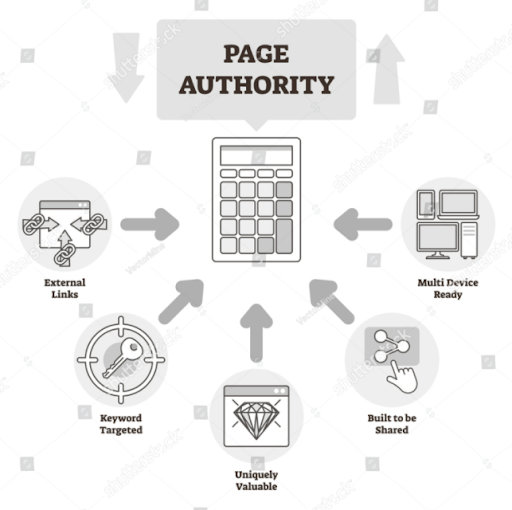 Although there has been a consensus on the difficulty of influencing page authority, the underlying value it brings to a website in terms of increasing visibility and organic traffic has forced SEO professionals to find ways to do so. One way to do it is by securing external links from popular and credible sources. The changes in SEO trends also affect the way we need to approach PA.
Although there has been a consensus on the difficulty of influencing page authority, the underlying value it brings to a website in terms of increasing visibility and organic traffic has forced SEO professionals to find ways to do so. One way to do it is by securing external links from popular and credible sources. The changes in SEO trends also affect the way we need to approach PA.
It all boils down to improving user experience
A favorable and positive user experience is the prerequisite for ensuring a better page ranking and increasing organic traffic. The usability of a website plays the most critical role in making it popular among prospective visitors. Attributes like site responsiveness ensure that users can access a website on multiple platforms with uniform ease of navigation on all of them; mobile compatibility of websites has taken the front seat over the years. The speed of page loading is another crucial factor in deciding the experience of a user — the faster the better(with decreased bounce rates).SEO best practices allow website developers to enhance user experience. Thus, staying in the loop of the latest SEO trends becomes a necessity, in addition to creating better quality content. Now, that we have understood the value and importance of SEO in deciding the fate of a website, our prerogative is to make an exhaustive analysis of the new SEO trends this year for rankings and visibility
All the SEO Trends in 2023 to look out for
The year 2020 saw major updates in Google search algorithms because of the never-seen dependence of people on the internet for most of their needs. The pandemic led to the shift to the internet prompting Google to push its user experience-based SEO model even further. As 2021 became a landmark year for organic search, the art of designing successful SEO strategies became more challenging. Embracing the ever-changing nature of SEO has never been more crucial. Hopping on the back of SEO updates pushed by Google through the last year, 2023 has been no different. Let’s dive into the updates and latest SEO trends of 2023 and learn about the SEO future.
1. User Experience assumes new meaning with Core Web Vitals
There was a time when page ranking heavily depended on keyword optimization and link building. That is not to imply that keywords, on-site optimization, and link building are no longer a part of SEO, but they have been supplemented with and overpowered in a way by the introduction of Core Web Vitals. As mentioned above, improving user’s page experience has been on Google’s top agenda in the last few years, and Core Web Vitals are just a step in that direction.
 incentivizing website developersPage experience has been measured so far using signals such as HTTPS, safety, and mobile-friendliness. Core Web Vitals are a crucial addition to this family. These are a set of metrics deployed to measure the loading, interactivity, and visual stability of a website. According to Google, the motivation behind implementing Core Web Vitals in its algorithm is incentivizing website developers to design and execute their website models keeping in mind an enhanced page experience for the users. Core Web Vitals consist of three metrics as follows:
incentivizing website developersPage experience has been measured so far using signals such as HTTPS, safety, and mobile-friendliness. Core Web Vitals are a crucial addition to this family. These are a set of metrics deployed to measure the loading, interactivity, and visual stability of a website. According to Google, the motivation behind implementing Core Web Vitals in its algorithm is incentivizing website developers to design and execute their website models keeping in mind an enhanced page experience for the users. Core Web Vitals consist of three metrics as follows:
First Input Display(FID) is used to compute the time taken in milliseconds from the first interaction of the user with a website element to the response of the browser to that interaction. FID gives a numerical value to the responsiveness of your website. A lower value of FID is desirable to ensure increased interactivity of a web page.
Largest Contentful Paint(LCP) is used to compute the time taken in seconds from the start of page loading to when every element on the page hasfinished loading. LCP gives a numerical value to the loading experience of users on a given web page. Again, the lower the value of LCP, the better the loading experience.
Cumulative Layout Shift(CLS) is used for computing nd attributing a score to all the unexpected shifts in the page layout within the viewport during the lifecycle of a page. CLS is a numerical measure of the page stability of a page. Visual stability is a vital element of user xperience, and a lower CLS value is considered desirable for a flawless experience. Therefore, SEO professionals need to pay attention to improving these metrics for increasing organic traffic to a website.
2. New Structured Data Markups for Video SEO
Video marketing has become an integral part of digital marketing for acquiring traffic and lead generation. Video marketing has been evolving by leaps and bounds as internet speeds have been on an upward trajectory. Videos are a great medium for telling stories and people are naturally wired for getting drawn to a good story. Capitalizing on this, video content-sharing platforms like YouTube have become the go-to avenue for the promotion of brands and video marketing.YouTube has been using the Key Moments feature, which displays particular points in the video with timestamps and mini titles. Now, Google is launching this feature for search results also, as declared during Google I/O 2022. Google has notified the introduction of two new features to help video content show on the search engine results pages(SERP). These features are ‘new structured data’ viz. Clip Markup and Seek Markup. Expanding the usability of Key Moments features to other video hosting platforms, in addition to YouTube, will make it easier to increase the click-through rate(CTR) on video content.
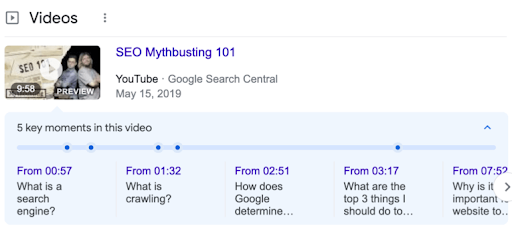 These two new dedicated structured data types allow for defining labels and timestamps for videos:
These two new dedicated structured data types allow for defining labels and timestamps for videos:
Clip Markup is a manual process where the information regarding the timestamp and label has to be embedded within the Video Object element of structured data. You have to specify the required timestamp and label manually so that Google knows what to display in the key moments.
Seek Markup, in contrast to Clip Markup, is the automated way to communicate the timestamps in a video to Google Search. Google understands how the URL structure of a video works to automatically identify and display key moments, using the properties of the related VideoObject. These features are still in their first iteration, and further improvements are expected as trends in SEO keep evolving
3. Artificial Intelligence: MUM set to take over BERT
Over the years, Google has been putting enormous funding and emphasis on the research and development of Artificial Intelligence(AI). It has been pushing developers to incorporate functional elements of the same in their search algorithms, wherever possible, even as AI has been in the process of taking a more solid form. Understanding the motivation and the intention behind a search has been on Google’s agenda for a long time to enhance the user experience by giving them the most relevant and accurate results for their search queries. The introduction of the BERT(Bidirectional Encoder Representations from Transformers) algorithm in 2019 was a concrete step in this direction.BERT incorporates a blend of Machine Learning and natural language processing(NLP) to develop an understanding of the relationship between the intent of search queries and words. BERT is mostly aimed at aiding the voice assistants to serve users better, as they are shifting towards speaking to the search engine instead of communicating with it through written words. BERT helped search engine bots to improve their conversational skills, and in turn, their ability to interpret the intent of the user behind a search query.
 In this sequence, Google I/O 2022 announced yet another leap in AI: the introduction of the Multitask United Model(MUM). MUM is a vastly improved successor to Google’s BERT as it possesses the ability to analyze images, text, and videos from 75 languages for answering complex search queries. It is an AI model programmed to understand the intent, feelings, and context of the user when they search for a query and to provide relevant search results. Services like Google Lens will benefit the most from the multifunctionality of MUM, as it will allow users to combine images, voice, and text to extract desired results to search queries. MUM is still in the testing phase and is expected to become fully functional very soon. If MUM is truly a successor to BERT, we should expect an even stronger emphasis on authority signals and user experience in all other SEO developments.
In this sequence, Google I/O 2022 announced yet another leap in AI: the introduction of the Multitask United Model(MUM). MUM is a vastly improved successor to Google’s BERT as it possesses the ability to analyze images, text, and videos from 75 languages for answering complex search queries. It is an AI model programmed to understand the intent, feelings, and context of the user when they search for a query and to provide relevant search results. Services like Google Lens will benefit the most from the multifunctionality of MUM, as it will allow users to combine images, voice, and text to extract desired results to search queries. MUM is still in the testing phase and is expected to become fully functional very soon. If MUM is truly a successor to BERT, we should expect an even stronger emphasis on authority signals and user experience in all other SEO developments.
4. Focus on User Behavior and Search Intent
User behavior keeps evolving rapidly in the digital age and shapes the way people approach the internet for their various needs. Google has been mindful of the changing user behavior over the years and has been tweaking its search algorithms to adapt and evolve with the same. The latest updates in Google’s search algorithms have signaled a shift towards prioritizing the search intent behind a user query and user behavior. Users depend on search engines to get answers to their various queries and navigate life in general by learning about different things. When businesses and brands develop a better understanding of what the users are looking for on the internet, they can cater to their needs and provide for them. Collectively, this is beneficial for both the users and businesses.
 Google has been implementing changes that are aimed at gauging the intent behind search queries of users through machine learning and artificial intelligence. As AI has been growing every day, Google has gotten better at reading the patterns users follow. Combining these patterns with the EAT guidelines, search engine trends have been getting skewed in favor of learning various eccentricities of internet users. Learning about user behavior and intent allows search engines to satiate their thirst for finding the most relevant information. Businesses need to analyze all data on the various interactions of organic leads on their websites; this will allow them to identify the on-site search keywords used by these leads on various pages. Making new content around these keywords helps in improving SERP rankings. Such an aggregation of user data also allows businesses to trace the content journey and make appropriate changes. In this way, when brands will start catering to the needs of the audience and new SEO developments, user engagement will improve drastically. Thus, SEO practitioners are required to understand what users are searching for and implement their strategies accordingly.
Google has been implementing changes that are aimed at gauging the intent behind search queries of users through machine learning and artificial intelligence. As AI has been growing every day, Google has gotten better at reading the patterns users follow. Combining these patterns with the EAT guidelines, search engine trends have been getting skewed in favor of learning various eccentricities of internet users. Learning about user behavior and intent allows search engines to satiate their thirst for finding the most relevant information. Businesses need to analyze all data on the various interactions of organic leads on their websites; this will allow them to identify the on-site search keywords used by these leads on various pages. Making new content around these keywords helps in improving SERP rankings. Such an aggregation of user data also allows businesses to trace the content journey and make appropriate changes. In this way, when brands will start catering to the needs of the audience and new SEO developments, user engagement will improve drastically. Thus, SEO practitioners are required to understand what users are searching for and implement their strategies accordingly.
5. Voice Search through Machine Learning Models: LaMDA
Over the years, voice search was robotic to a great extent and oddly specific with what users could achieve through it. But that is set to change as Google is working on its voice search algorithm to make it as close to a human experience as possible with the help of the latest leaps in technology. Machine Learning has been a mainstay at Google over the past few years as it has been a vital part of many algorithms and learning models primed for a digital future. One of the latest examples of the same was seen during the announcement of a new machine-learning model called Language Model for Dialogue Applications(LaMDA) at Google I/O 2022. LaMDA is a result of years of machine-learning research at Google and it’s based on Google’s neural network architecture – Transformer.
 Google Assistant(or others like Amazon’s Alexa and Apple’s Siri, etc.) became a part of our daily lives in the last couple of years as more and more internet users started giving basic voice commands to get their tasks done and to convey their search queries. LaMDA is aimed at making the nature of voice search and commands conversational and more human.As a program, it can be trained to read multiple words and discern the relationship between these words to predict the ones that might follow. It gets its ability to identify and predict dialogue because Google trained this machine-learning model on real-world conversations.Based on research and observations, voice search performs better when users are descriptive about their queries and don’t abbreviate like when they type keywords for searching answers to their queries. LaMDA is programmed to make this more efficient by being conversational and predicting the voice descriptions fed by users.LaMDA is just a mini step in the long-term strategy at Google, as more advanced AI and ML models will improve the conversational skills of the voice search assistant — this will help to find more accurate, faster, and to-the-point results for search queries of the users. Therefore, now is the time for SEO experts to optimize the websites they work on for voice search.
Google Assistant(or others like Amazon’s Alexa and Apple’s Siri, etc.) became a part of our daily lives in the last couple of years as more and more internet users started giving basic voice commands to get their tasks done and to convey their search queries. LaMDA is aimed at making the nature of voice search and commands conversational and more human.As a program, it can be trained to read multiple words and discern the relationship between these words to predict the ones that might follow. It gets its ability to identify and predict dialogue because Google trained this machine-learning model on real-world conversations.Based on research and observations, voice search performs better when users are descriptive about their queries and don’t abbreviate like when they type keywords for searching answers to their queries. LaMDA is programmed to make this more efficient by being conversational and predicting the voice descriptions fed by users.LaMDA is just a mini step in the long-term strategy at Google, as more advanced AI and ML models will improve the conversational skills of the voice search assistant — this will help to find more accurate, faster, and to-the-point results for search queries of the users. Therefore, now is the time for SEO experts to optimize the websites they work on for voice search.
6. Improvement in Predictive Search
Intelligent search functionality can improve search performance for keywords entered by the users, which in turn, goes on to increase the CTR(click-through rate) and overall conversions for a website. Predictive search is an effective technique when it comes to improving user interactivity, be it on the search engine or when implemented within a website. Predictive search not just increases customer engagement, but it also makes the search experience better by providing the required help to find the most relevant keywords for obtaining accurate results. Predictive search provides auto-suggestions to user inputs and incorporates the best keywords in their search queries. Not just voice search, Artificial Intelligence, and Machine Learning models have been incorporated into the normal text-based search as well, and predictive search benefits from them directly. AI has been improving at a fast pace and therefore, predictive search has never been any better when it comes to accuracy and user satisfaction.Starting from 2008, autocomplete of Google features has reached greater heights today, with users opting for faster and more precise predictive suggestions whenever they manually type their search queries. Keeping this in mind, Google has focused a great deal on making its machine-learning algorithms adaptive to user search intent, as discussed above.
7. From Pages to Passages: Passage Indexing and Ranking
Last year, Google announced the launch of a new algorithm called passage indexing, which uses its natural language processing(NLP) feature for indexing pages on the internet. It went live as a passage ranking in February 2022. The aim is to allow the search bots to not just look for keywords in content but also understand the meaning of every passage within a web page. Passage Indexing offers the ability to display specific passages inside an article that are relevant for a given search query, even if the said passage is buried deep within a long-form article. It is more than just an internal ranking system and is set to impact rankings and results in the SERP — holistic and well-structured content will benefit the most.  Long-tailed queries and search queries in question form will fetch more accurate and relevant results with the help of the Passage Indexing Ranking Algorithm. The reason is that highly specific queries require specific search results that can do justice to the queries in question. Passage Indexing finds the best possible answers from a sea of valid sources.Moving on from the current page indexing, which works according to the relevance and context of an entire web page, passage indexing will look for relevance and context concerning a search query within individual passages of text in a given web page. Therefore, SEO experts need to emphasize the structure of the content more than ever before because a well-defined structure will be the kingmaker.
Long-tailed queries and search queries in question form will fetch more accurate and relevant results with the help of the Passage Indexing Ranking Algorithm. The reason is that highly specific queries require specific search results that can do justice to the queries in question. Passage Indexing finds the best possible answers from a sea of valid sources.Moving on from the current page indexing, which works according to the relevance and context of an entire web page, passage indexing will look for relevance and context concerning a search query within individual passages of text in a given web page. Therefore, SEO experts need to emphasize the structure of the content more than ever before because a well-defined structure will be the kingmaker.
8. Focus on Online Shopping: Shopping Graph
For a long time, Google has lagged in its capabilities for online shopping. Despite the long existence of Google’s Shopping search engine, it never became as relevant and popular as Amazon and others. But that is set to change as the launch of Shopping Graph was announced recently. Shopping Graph is yet another artificial intelligence model that seeks to grasp the forever-changing status of products, brands, reviews, and sellers through directly received product information and inventory data from retailers and brands in real-time— all while establishing the relationship between all of the aforementioned attributes.
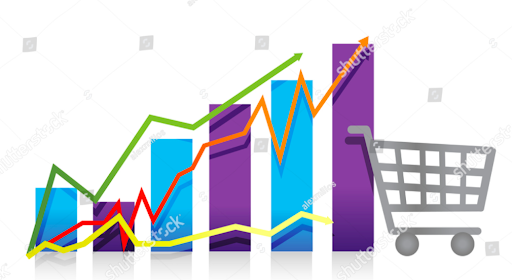 Since the Shopping Graph works in real-time, it helps users make more informed decisions regarding their prospective purchases by helping them discover products and offers available at the time of their purchase. It comes with a few more extensions and features such as:
Since the Shopping Graph works in real-time, it helps users make more informed decisions regarding their prospective purchases by helping them discover products and offers available at the time of their purchase. It comes with a few more extensions and features such as:
- Linked Loyalty Programs: With this feature, brands will be able to link loyalty programs offered by them directly into a user’s Google account, making it easier for them to access the benefits offered through
these programs. - Affordable Picks Carousel: It aggregates all items matching the query cheaply. It’s currently in the testing phase and will be available on mobile devices.
- Latest Deals: Users can now find all exciting offers and discounts across various e-commerce platforms, brand websites, and nearby retailers all in one place — SERPs. All they need to do is search for the
required items.
9. Increasing the Value of Featured Snippets
A featured snippet, also known as position zero, is found at the top of SERP inside a rectangular box. It was launched in 2017 and has since become a shortcut for achieving prominence in Google search rankings. Generally, a featured snippet appears when the search query is in the form of a specific question, and a well-structured search result is expected by the user. The first organic link on SERP is inarguably the most sought-after position for increasing CTR and generating organic traffic to a website. The featured snippet feature provides the opportunity to rank in the first coveted position and steer away from a significant chunk of traffic from competitors.
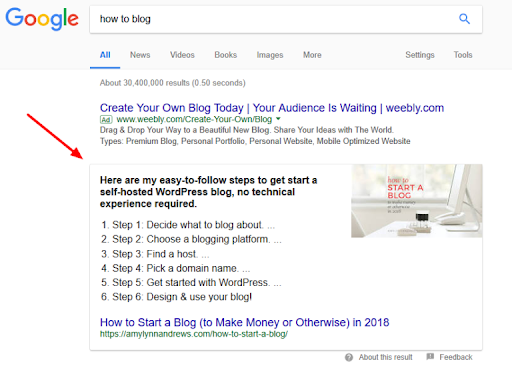 Featured snippets, as mentioned above, are generated against detailed and specific search queries and appear in the form of bullet points, question-answers, how-to guides, etc. These snippets may also include images, prices for products, reviews, and other similar pieces of information — called rich snippets. Though featured snippets were introduced in 2017, given the enhanced AI capability of search bots in 2022, the effectiveness of this feature has improved majorly. Today, search bots are more capable of finding these snippets from deep inside a web page as passage ranking has become a reality. Therefore, SEO new trends call for making the content of a web page detailed and structured, with the incorporation of Q&A, bullet points, and how-to guides.
Featured snippets, as mentioned above, are generated against detailed and specific search queries and appear in the form of bullet points, question-answers, how-to guides, etc. These snippets may also include images, prices for products, reviews, and other similar pieces of information — called rich snippets. Though featured snippets were introduced in 2017, given the enhanced AI capability of search bots in 2022, the effectiveness of this feature has improved majorly. Today, search bots are more capable of finding these snippets from deep inside a web page as passage ranking has become a reality. Therefore, SEO new trends call for making the content of a web page detailed and structured, with the incorporation of Q&A, bullet points, and how-to guides.
10. EAT is here to stay: Updates and Refinements
Ever since Google rolled out EAT in 2018, websites have been pushed to maintain overall content quality to avoid penalties. AI at Google has been getting better in the 2 years since then, and combined with machine-learning algorithms at play, it’s become a routine to determine and match the sources of various content across the internet to weeding out duplicity. The EAT principle works based on expertise, authoritativeness, and trustworthiness. The quality of a web page and its content is determined by a combination of these three factors. EAT guidelines are especially relevant for businesses falling under the YMYL umbrella(your money, your life), like finance.
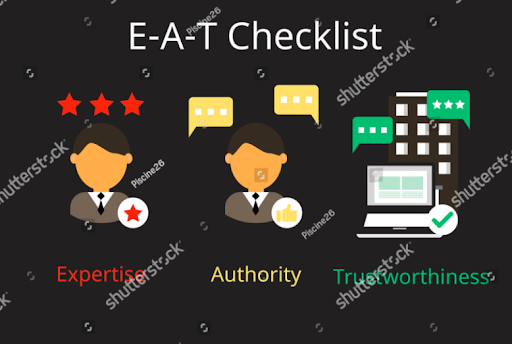 Enhancing and maintaining a standard page quality has never been more important than in 2022, as Google is going all guns blazing to ensure that user experience becomes the most crucial consideration for businesses. It is more important than ever for businesses to understand what their prospective customers might need and cater to those needs through quality content. Staying true to EAT guidelines is the key. Websites must be optimized based on the EAT principle to increase their value and rankings on the SERP. EAT might not be the latest SEO principle but, the increased focus on page quality in 2022 (and the years to follow) has only made it one of the major SEO developments in recent years.
Enhancing and maintaining a standard page quality has never been more important than in 2022, as Google is going all guns blazing to ensure that user experience becomes the most crucial consideration for businesses. It is more important than ever for businesses to understand what their prospective customers might need and cater to those needs through quality content. Staying true to EAT guidelines is the key. Websites must be optimized based on the EAT principle to increase their value and rankings on the SERP. EAT might not be the latest SEO principle but, the increased focus on page quality in 2022 (and the years to follow) has only made it one of the major SEO developments in recent years.
11. SERP rankings will depend on Long-Form Content
There has been a trend recently where articles and blogs exceeding 3000 words garner thrice the traffic and four times the shares as compared to shorter reads. Not just that, the number of backlinks on such long-form articles is also considerably higher. Even when long-form content is the need of the hour, maintaining a constant quality throughout is also equally important. Quality content helps in improving user experience and improves page rankings as it keeps users engaged and has inherent shareability. Now the question is, how can we maintain quality in long-form content?
 The answer lies in dividing the content into various sections and subheadings to make it scannable by search bots. Doing so also makes the content easy to read and increases user engagement. Another important consideration is placing multiple relevant links from authoritative sources — all content must adhere to the EAT principle. Lastly, it is vital to place quick sharing links at multiple places throughout the article — preferably at the top and bottom of the content.Following the above guidelines can make your long-form content easily accessible and help your website rank better on the SERP.
The answer lies in dividing the content into various sections and subheadings to make it scannable by search bots. Doing so also makes the content easy to read and increases user engagement. Another important consideration is placing multiple relevant links from authoritative sources — all content must adhere to the EAT principle. Lastly, it is vital to place quick sharing links at multiple places throughout the article — preferably at the top and bottom of the content.Following the above guidelines can make your long-form content easily accessible and help your website rank better on the SERP.
12. Keyword Search: Increased Emphasis on Semantically Related Keywords
 As discussed above, now Google is focused on analyzing the intent behind a user’s search query and matching it with the context of the keywords. Unlike earlier, when more importance was placed on primary keywords, today, secondary keywords have also gained prominence. With this, intent optimization and semantic search are primed to take over the driver’s seat in searching for relevant keywords.The need of the hour is to implement primary and secondary keywords that are related logically and provide the most relevant information against user queries. For achieving this, semantically related keywords must be identified and duly added to the body of the content on a website.Semantic keywords can be best implemented when content is designed and optimized for a group of topics instead of particular keywords. The content should aim to answer questions posed by the target audience, solve their queries and provide appropriate solutions. The key is to ensure that we write content with a human touch, for people, and not for search bots.To sum up, the latest SEO trends revolve around the needs of the user, and therefore, businesses must be ready to change their approach to a user-centric one instead of revolving solely around search algorithms.
As discussed above, now Google is focused on analyzing the intent behind a user’s search query and matching it with the context of the keywords. Unlike earlier, when more importance was placed on primary keywords, today, secondary keywords have also gained prominence. With this, intent optimization and semantic search are primed to take over the driver’s seat in searching for relevant keywords.The need of the hour is to implement primary and secondary keywords that are related logically and provide the most relevant information against user queries. For achieving this, semantically related keywords must be identified and duly added to the body of the content on a website.Semantic keywords can be best implemented when content is designed and optimized for a group of topics instead of particular keywords. The content should aim to answer questions posed by the target audience, solve their queries and provide appropriate solutions. The key is to ensure that we write content with a human touch, for people, and not for search bots.To sum up, the latest SEO trends revolve around the needs of the user, and therefore, businesses must be ready to change their approach to a user-centric one instead of revolving solely around search algorithms.
13. Automation is more important than ever
By now, it must have become clear that Artificial Intelligence(AI), Machine Learning(ML), and natural language processing(NLP) have become the pillars of technology in the present day. Google has been working on automating most of the high-functioning technical work it undertakes to improve efficiency and remove the scope of human error.
 The influence of this automated approach can be seen in most of the SEO new trends announced in the last couple of years. It’s out in the open that writing more content and optimizing it for search engines is an expensive and time-intensive undertaking. This is where automation can make things easier for businesses.Businesses and organizations have started turning towards AI to generate reports about their data and find faults that need to be rectified. Automated tools such as AI-driven keyword search tools are becoming more common. Not just that, AI has even been getting better at producing content, both with improved quality and quantity. Even though the commercial use of AI content writing may take some time, the groundwork has been laid already.Automation through AI and ML will take over the digital world, and it is advisable to join the bandwagon, albeit with some caution. The human factor will always remain crucial to weed out biases generated by imperfect automation tools. Nevertheless, apart from a necessary cautious approach, overlooking automation may be a sign of staying behind the times.
The influence of this automated approach can be seen in most of the SEO new trends announced in the last couple of years. It’s out in the open that writing more content and optimizing it for search engines is an expensive and time-intensive undertaking. This is where automation can make things easier for businesses.Businesses and organizations have started turning towards AI to generate reports about their data and find faults that need to be rectified. Automated tools such as AI-driven keyword search tools are becoming more common. Not just that, AI has even been getting better at producing content, both with improved quality and quantity. Even though the commercial use of AI content writing may take some time, the groundwork has been laid already.Automation through AI and ML will take over the digital world, and it is advisable to join the bandwagon, albeit with some caution. The human factor will always remain crucial to weed out biases generated by imperfect automation tools. Nevertheless, apart from a necessary cautious approach, overlooking automation may be a sign of staying behind the times.
14. Spotlight on Local Search
The internet is a truly global platform and connects people and businesses from all across the world instantly. Unsurprisingly then, it also offers impeccable local connectivity. Search engines come in handy when people look for localized goods and services, for example, finding the nearest grocery store, smartphone repair shop, or restaurant. Local search has been a cornerstone of all search algorithms and strategies for a long time but its importance is increasing every day. In 2022, the world has barely recovered from the jolt of the global pandemic and local search results have become more important than ever — which gained more prominence during the worldwide lockdowns.
 The advent of featured snippets has given rise to a phenomenon called zero-click searches, wherein the users find the answer to their query through the SERP itself. As has been observed, many of these zero-click searches are local searches. Now, one may ask, what is the way of featuring in these zero-click searches?To begin with, a website needs to maintain a solid backlink profile for increasing its chances of appearing in the featured snippets. Google My Business pages also play a big role in bringing a business closer to finding its way into zero-click searches. SEO experts must utilize local keywords, develop content about local news & events, and use online local business directories.
The advent of featured snippets has given rise to a phenomenon called zero-click searches, wherein the users find the answer to their query through the SERP itself. As has been observed, many of these zero-click searches are local searches. Now, one may ask, what is the way of featuring in these zero-click searches?To begin with, a website needs to maintain a solid backlink profile for increasing its chances of appearing in the featured snippets. Google My Business pages also play a big role in bringing a business closer to finding its way into zero-click searches. SEO experts must utilize local keywords, develop content about local news & events, and use online local business directories.
15. Internal Linking never went out of business
Internal linking is one of the older tricks in the SEO book and has been integral in improving the ranking of a web page on the SERP. Just because this tactic has existed for a long time doesn’t mean its relevance has faded. Internal linking is helpful for both the search engine and the users as they ease the process of finding relevant web pages. Therefore, even today, it is one of the most crucial SEO trends.
 Unlike Google, which can use XML sitemaps for navigation purposes, users have to navigate manually, and it can become tedious and time-consuming if the website contains a multitude of pages/posts to go through. It is imperative to create suitable internal links for making a user’s navigation experience better. Some of the tactics to establish a clear site hierarchy through internal linking are:
Unlike Google, which can use XML sitemaps for navigation purposes, users have to navigate manually, and it can become tedious and time-consuming if the website contains a multitude of pages/posts to go through. It is imperative to create suitable internal links for making a user’s navigation experience better. Some of the tactics to establish a clear site hierarchy through internal linking are:
- Creating pages dedicated to specific topics and placing all relevant links to a topic on its page.
- Using filter tools to allow users to narrow down their options of links to choose from.
- Creating hyperlinks to other similar content in blogs.
- Placing links to similar products/services/videos/blogs on the bottom of every page of a website.
Conclusion
To sum up, SEO trends in 2023 are an amalgam of cutting-edge improvement in digital technology and tried and tested methods. Artificial Intelligence and Machine Learning have manifested their presence in most of the new SEO algorithms and models. MUM, BERT, LaMDA, featured snippets, passage ranking, etc., have become vital components in the SEO industry. Video-structured data have also become a crucial part of the SEO setup. At the same time, basic SEO techniques such as internal linking, maintaining the quality of content, increasing automation, focusing on local search, keyword optimization, etc., have cemented their presence amidst all new SEO trends. If you want to stay at the top of the search engine result page, you need to make a note of all of the above trends and optimize your website under them. Once you do that efficiently, search engine algorithms will favor your website in the SERP.
FAQs
How Do I Find SEO Trends?
To find SEO trends, here are a few steps you can follow:
- Google Alerts: Set up Google Alerts for keywords related to your industry. They send email notifications when there are new trends or articles.
- SEO Blogs: There are many popular SEO blogs you can read to stay updated on the latest trends and tips, like Moz, Search Engine Journal, and SEMrush.
- SEO Tools: Use tools like Google Trends, Ahrefs, and SEMrush to track keyword and search trends.
- Social Media: To get insights and trends regularly, follow SEO experts on Twitter, Threads, LinkedIn, or other social media platforms.
- YouTube and Podcasts: Subscribe to SEO YouTube channels and podcasts as they discuss current trends and strategies.
- Forums and Communities: Join SEO forums like Reddit’s r/SEO, where people share trends and experiences.
To keep your SEO game strong, you have to keep yourself updated.
Is Seo Still Relevant In 2023?
Yes, SEO is still crucial in 2023, and it will also be in the future. Because SEO helps search engines like Google crawl your website and gather information to categorize so that the website can rank higher on search engines. This matters because most people use search engines to find information and products online.
SEO makes your website easily discoverable, increasing traffic and potential customers. Though the methods may evolve, the core principles of SEO remain relevant: quality content, proper keywords, user-friendly designs, and mobile-friendly content. So, investing in SEO is still smart if you want your website to succeed and reach more people.
Why Is SEO Important For Your Web Site In 2023?
SEO is important for your website even in 2023 because it helps your site get noticed by search engines like Google. People who search for information online usually click on the first few results. SEO makes sure that your website appears higher in those results. So that more people can visit your site.
With so many websites out there, SEO also helps you stand out, just like putting a big sign on your digital storefront. It makes your site user-friendly, so people stay longer and return for more. In 2023, if you want your website to succeed, SEO is still your best friend.






